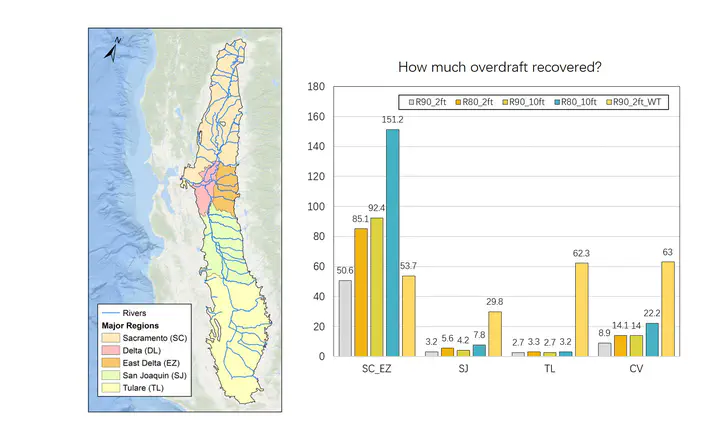Can Managed Aquifer Recharge mitigate the groundwater overdraft in California’s Central Valley?
Abstract
Groundwater plays a critical role in sustaining agriculture in California’s Central Valley (CV). However, groundwater storage in the CV has been declining by around 3 cubic km per year over the last several decades, with much larger declines during the 2007‐2009 and 2012‐2015 droughts. Managed Aquifer Recharge (MAR) can potentially mitigate existing overdraft by recharging excess streamflows (during flood periods) to the aquifers. However, the degree to which the existing CV groundwater overdraft might be mitigated by MAR is unknown. We applied a coupled surface water‐groundwater simulation model to quantify the potential for groundwater overdraft recovery via MAR. To quantify the potential benefit of MAR, we used the coupled surface water‐groundwater model to simulate water allocation scenarios where streamflow above the 90th or 80th percentiles was reallocated to aquifers, subject to constraints on the maximum depth of applied water (0.61m and 3.05m). Our results show that MAR could recover 9%‐22% of the existing groundwater overdraft CV‐wide based on a 56‐year simulation (1960‐2015). However, the impact of MAR varies strongly among regions. In the southern CV where groundwater depletion is most serious, the contribution of MAR to the overdraft recovery would be small, only 2.7%‐3.2% in the Tulare basin and 3.2%‐7.8% in the San Joaquin basin. However, transferring excess winter flow from the northern to the southern CV for MAR would increase the overdraft recovery to 30% in San Joaquin and 62% in Tulare. Our results also indicate that MAR has the potential to supplement summer low flows (52%‐73%, CV‐wide) and reduce flood peaks.
